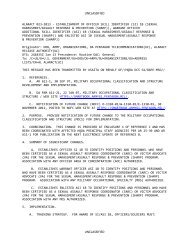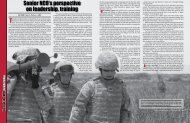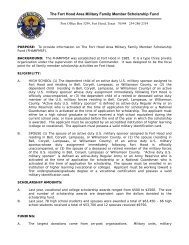Testing in a Joint Environment Roadmap - U.S. Army Operational ...
Testing in a Joint Environment Roadmap - U.S. Army Operational ...
Testing in a Joint Environment Roadmap - U.S. Army Operational ...
You also want an ePaper? Increase the reach of your titles
YUMPU automatically turns print PDFs into web optimized ePapers that Google loves.
For Official Use Only<br />
<strong>Test<strong>in</strong>g</strong> <strong>in</strong> a Jo<strong>in</strong>t <strong>Environment</strong> <strong>Roadmap</strong><br />
fundamental to enable <strong>in</strong>teroperability among all components of the jo<strong>in</strong>t mission <strong>in</strong>frastructure,<br />
it will either be owned by the Government or centrally licensed, so that it can be provided "free<br />
of charge" to organizations <strong>in</strong>terfac<strong>in</strong>g to the jo<strong>in</strong>t mission <strong>in</strong>frastructure.<br />
B.2.3.3 BASIC OBJECT MODELS<br />
Standard data def<strong>in</strong>itions and def<strong>in</strong>ed <strong>in</strong>terfaces are critical to streaml<strong>in</strong>e <strong>in</strong>tegration of the<br />
jo<strong>in</strong>t mission <strong>in</strong>frastructure. Prescrib<strong>in</strong>g the <strong>in</strong>terface, data, and functionality, an object model<br />
enables semantic <strong>in</strong>teroperability among the various capabilities <strong>in</strong> the jo<strong>in</strong>t mission<br />
<strong>in</strong>frastructure by prov<strong>in</strong>g a standard "language" that all systems use to communicate. This<br />
capability is essential to provide semantic understand<strong>in</strong>g between operations of diverse systems.<br />
Classic examples of object models <strong>in</strong>clude the entities <strong>in</strong> the exercise (airplane, tank, ship, threat<br />
systems, terra<strong>in</strong> features, etc.) as well as support<strong>in</strong>g systems, such as <strong>in</strong>strumentation systems<br />
(radar, Global Position<strong>in</strong>g System, telemetry, etc.). Object models encode all the <strong>in</strong>formation<br />
exchanged between systems. To assist developers <strong>in</strong> design<strong>in</strong>g their <strong>in</strong>terface to the jo<strong>in</strong>t<br />
mission <strong>in</strong>frastructure, it is critical to provide "build<strong>in</strong>g block" object models that are segmented<br />
and standardized across communities of <strong>in</strong>terest. Therefore, rather than hav<strong>in</strong>g to build their<br />
<strong>in</strong>terfaces either from scratch or by try<strong>in</strong>g to re-eng<strong>in</strong>eer object def<strong>in</strong>itions from past events for<br />
different purposes, developers will have a variety of standard <strong>in</strong>terface def<strong>in</strong>itions that they<br />
leverage to compose the def<strong>in</strong>ition of their larger system. Examples of Basic Object Models<br />
<strong>in</strong>clude ubiquitous data def<strong>in</strong>itions (e.g., time and position), as well as generic def<strong>in</strong>itions (e.g.,<br />
platform), which every developer could utilize. Basic Object Models also <strong>in</strong>clude standard<br />
software algorithms, such as coord<strong>in</strong>ate translations and conversion routes. Incorporat<strong>in</strong>g<br />
standard software algorithms with Basic Object Models is critical to m<strong>in</strong>imize "translation error"<br />
and other impacts from the jo<strong>in</strong>t mission <strong>in</strong>frastructure that could obscure true effects or<br />
otherwise h<strong>in</strong>der an evaluator <strong>in</strong> trac<strong>in</strong>g the root cause of problems back to a particular system.<br />
B.2.3.4 TOOLS AND UTILITIES<br />
The Tools and Utilities provide functionality that allows the jo<strong>in</strong>t mission <strong>in</strong>frastructure to<br />
serve as a useful test environment and to operate efficiently and cleanly. The tools consist of a<br />
suite of software applications used to plan, prepare, configure, operate, monitor, and analyze the<br />
results of a jo<strong>in</strong>t test event <strong>in</strong>volv<strong>in</strong>g the jo<strong>in</strong>t mission <strong>in</strong>frastructure. Plann<strong>in</strong>g tools will make it<br />
easy to schedule <strong>in</strong>corporation <strong>in</strong>to a pre-planned event <strong>in</strong> the jo<strong>in</strong>t mission <strong>in</strong>frastructure,<br />
<strong>in</strong>clud<strong>in</strong>g determ<strong>in</strong><strong>in</strong>g which DoD capabilities are needed based upon the test objectives and<br />
def<strong>in</strong><strong>in</strong>g the scenario derived from the jo<strong>in</strong>t mission environment. In addition, these plann<strong>in</strong>g<br />
tools will help test eng<strong>in</strong>eers map test objectives and needed test resources by drill<strong>in</strong>g down from<br />
the operational architecture of the jo<strong>in</strong>t mission environments. One significant tool essential to<br />
transform test<strong>in</strong>g <strong>in</strong> a jo<strong>in</strong>t environment is the schedul<strong>in</strong>g tool for events and support<strong>in</strong>g assets,<br />
<strong>in</strong>clud<strong>in</strong>g all elements of the jo<strong>in</strong>t mission <strong>in</strong>frastructure. Schedul<strong>in</strong>g of the assets <strong>in</strong> the jo<strong>in</strong>t<br />
mission <strong>in</strong>frastructure, especially live assets participat<strong>in</strong>g <strong>in</strong> exercises, will be a complex<br />
B-6<br />
For Official Use Only<br />
Appendix B






